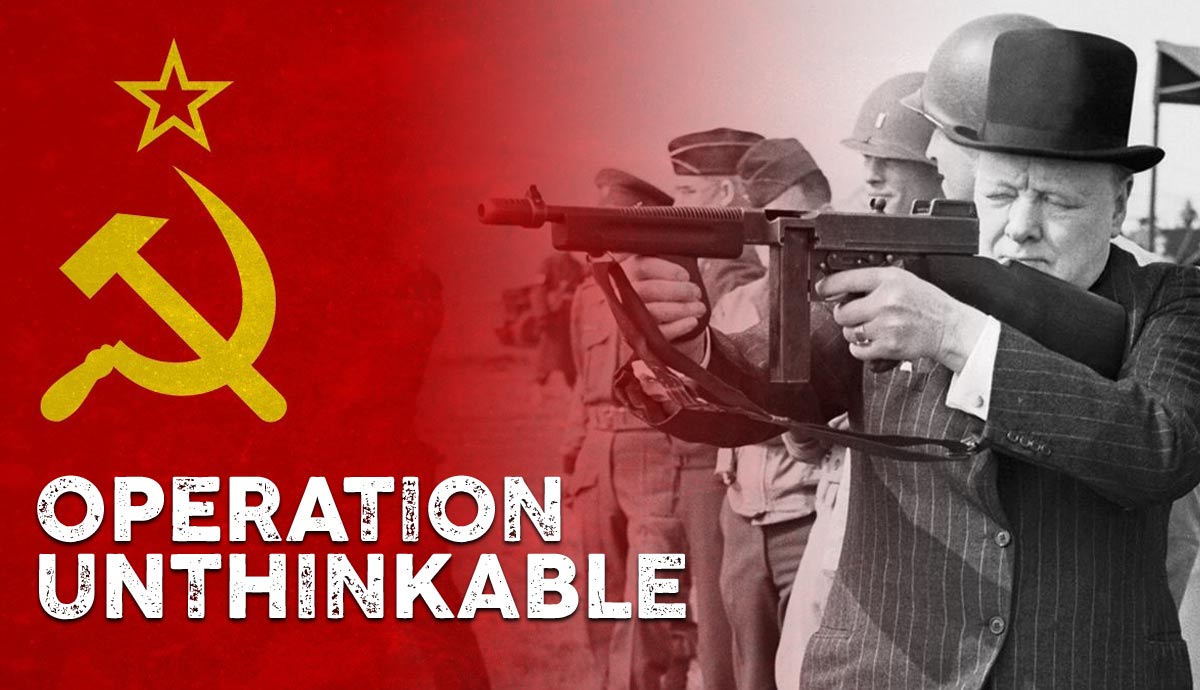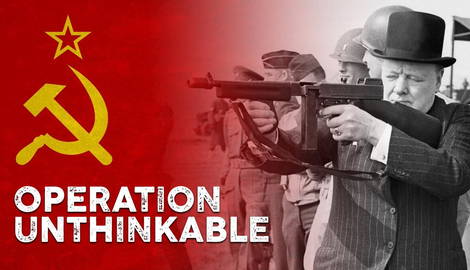
From 1939 to 1945, Europe was embroiled in a conflict that cost, by some estimates, as many as 80 million lives. It left the continent in ruins and introduced a trauma that is still with us today.
In May 1945, the Soviets rolled over Berlin. Hitler shot himself, and the Germans surrendered, bringing an end to the deadliest war in human history. Another threat, however, lurked on the horizon. As the industrial might of the United States and the Soviet Union reached unprecedented heights, even before the end of the war, it became clear that a new, even deadlier conflict was possible.
Thus, the Joint Planning Staff Committee was ordered to research military operations that would start a new war as a preemptive action to limit the Soviet Union’s power and westward advance.
This was known as Operation Unthinkable.
The End of the Second World War

At the end of the First World War, Russia, and, by extent, the Soviet Union, was in complete shambles. Communist revolution had ousted the Tsar, and the country was in the grip of a bloody civil war.
Less than three decades later, it emerged from the fires of the Second World War as a superpower with an incredibly large military capability. It occupied the territories of its former enemies as well as the countries liberated from German control.
The whole of Eastern Europe fell under the influence of Moscow. Winston Churchill was well aware that Stalin would keep hold of these territories and set up communist puppet governments, effectively making the Soviet Union even more powerful.
The Fate of Eastern Europe

Concerned for the future of Europe, Churchill had plans to “impose upon Russia the will of the United States and the British Empire,” even if it meant sparking a third world war. It was a brazen plan, to be sure, but it was one born out of desperation and fear of what the Soviet Union could achieve.
The Allies, seeing the incredible achievements of the Soviet Union in the final months of the war, acknowledged that underestimating Stalin and his forces was foolhardy. It was widely believed that Stalin would not stop at Berlin and that after defeating Germany, he would order Soviet forces to continue westwards.
At the forefront of Churchill’s mind was the fate of Poland. He was extremely unhappy with Poland falling under Soviet control, and his plans focused on liberating the country in a surprise attack. He commanded the plan to be drawn up in complete secrecy. In doing so, he wished to understand the feasibility of using force to stop the Soviet Union’s encroachment on the rest of Europe.
Churchill’s Fears

As the war drew to a close with major Soviet advances, Churchill received reports that led him to conclude that many matters had to be settled with the Soviets to prevent a third world war.
Churchill was further alarmed by the decision to allow the Soviets to take Berlin. He viewed the massive buildup of millions of troops there as a potential threat, believing that the Soviets may not stop their advance and keep driving into the western half of Germany and possibly beyond.
He sent a telegram to Roosevelt informing the American president of his concerns, but Roosevelt was not interested in Churchill’s fears. Roosevelt thought that at this stage, the war against Japan would drag on into 1946, and he was hoping Stalin would declare war on the Empire of Japan and help defeat America’s enemy in the East.
He flatly refused to entertain Churchill’s notions and told the British prime minister that while they may be allies, the United States would never help Britain “hold on to its archaic, medieval empire.”

In April, Roosevelt died and was succeeded by Harry S. Truman. As Churchill discovered, Truman took a harder line with Stalin, and the British prime minister was delighted that the United States commander-in-chief now shared a similar vision. Truman’s stance, however, would be reined in by the State Department, which thought it better to avoid stoking the fires of conflict with the Soviet Union at this point.
As the war came to a close, there were fears on the front lines as well. In the north of Germany, the Allies received unconfirmed reports of Soviet paratrooper landings in Denmark. Naturally, these reports were relayed back to Churchill.

In addition, Churchill was, at this point, receiving many reports of widespread rape and destruction caused by Soviet troops in Berlin as well as in other territories occupied by the Soviets.
Another factor influencing Churchill to investigate further action was the stripping of factories in Germany and Eastern Europe of parts that were taken back to the Soviet Union. These actions were especially widespread in Poland, and it proved to Churchill that Stalin was not upholding his end of the deal struck in Yalta earlier that year.
It became plainly obvious that Stalin had no intention of allowing Poland to return to democracy, as the Western Allies had wished.
Military Considerations

It was clear that if the plan went ahead, the Western Allies would be outnumbered in virtually all military areas. By June 1, it was estimated that the Allies would have only 80 infantry divisions to oppose the Soviet’s 228. In terms of armored divisions, the Allies had 20 and the Soviet’s 36.
The Allies would also be outnumbered in the air. The Soviets had an estimated 13,000 aircraft of all types, while the Allies had just under 9,000.
In addition to these numbers, it was clear that while the Soviets had lost millions of troops in the first stages of the war, by the end of the war, they had achieved parity with the German capabilities. The Soviet army had gone from strength to strength and was highly motivated, well-trained, and extremely effective.
Required Circumstances

Of course, launching a war directly after the end of the most devastating war in history was not an issue that was approached with any degree of nonchalance. The Joint Chiefs of Staff drew up a list of circumstances that had to be met before any casus belli could be declared.
It was assumed that since the Soviet Union had not declared war on Japan yet, Stalin would ally the Soviet Union with Japan instead. The likelihood of this was a real consideration that the Joint Chiefs of Staff had to consider, and thus, it became a prerequisite for opening Western Allied hostilities against the Soviet Union.
It was also necessary to ensure the reliability of the alliances. The United Kingdom and the United States were expected to provide the bulk of the fighting force, which would be augmented by Canadian and German divisions. It was also necessary to attain assurances from the Poles that they would rise up against the Soviets.
Military considerations aside, it was also necessary to gain the full support of the British and American public. This requirement was highly unlikely to be met. Although aware of the danger the Soviets posed, it is unlikely that the majority of the populations would have supported a continuation of hostilities, especially in the United Kingdom, where the war had taken a terrible toll.
The Proposed Attack

Operation Unthinkable laid out two routes of attack. It is unknown exactly what these plans entailed, as the maps that were drawn up were either destroyed or never released to the public. It is salient to point out that the conception of Operation Unthinkable itself was only made public knowledge in 1998.
The first route would require an armored thrust in the north towards the Baltic States. The second route would move southwest of Berlin towards Wrocław. It was clear that if this latter attack moved too far eastwards, the flanks would be exposed to attack from Soviet troops stationed in and around Czechoslovakia.
The plan had to be implemented with lightning speed and an element of surprise. The idea was that the quick punch to liberate Poland would shock Stalin and force him to the negotiation table.
Report Conclusions

Fortunately, the report that Churchill received about the possibility of achieving success made it very clear that an attack on Soviet forces would have disastrous consequences.
A quick victory, however unlikely, would still be possible, but if its effects were to have any lasting power, Russia (as the report refers to the Soviet Union throughout) would have to be completely defeated. Thus, a total war would be necessary to ensure Poland stayed out of Soviet control.
The report states,
“Even if all goes according to plan, we shall not have achieved, from the military point of view, a lasting result. The military power of Russia will not be broken and it will be open to her to recommence the conflict at any time she sees fit.”
It was also concluded that if war with the Soviet Union broke out, it would be impossible to limit it to a single theater, and it would, in all likelihood, end up being a global conflict.

It is impossible to accurately imagine what might have happened had Operation Unthinkable come to fruition. It was hoped that a quick operation would force the Soviets out of Poland and that the Soviets would accept the outcome and agree to peace terms. This was an extremely risky gamble.
It was very likely that this would not occur, that the Western Allies and the Soviets would end up engaged in a protracted war and that if the Soviets achieved victory, they would extend their control even further into Western Europe.
Fortunately for everyone, Operation Unthinkable was shelved.










